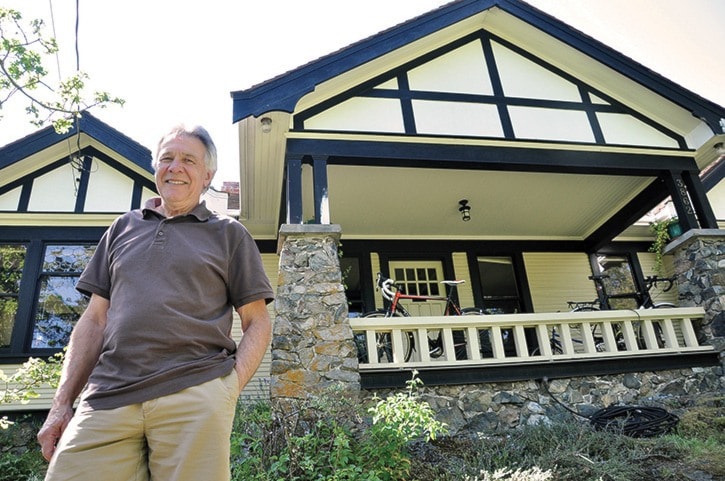If the handcrafted stonework, jutting window casements or ornate gabled roofing doesn’t give away the age of a house, remnants of a so-called California cooler just might.
A square hatch on the side of David Cubberley’s home is all that remains of pre-refrigeration food storage – a cabinet with high and low ducts that promoted air circulation – in his 1913 bungalow.
Hundreds of grand old homes in Greater Victoria are celebrating their first century this year. Circa 1913 was a golden era for residential construction – hundreds of houses went up to meet a growing influx of immigrants, and matched the expansion of railway lines through Victoria and the Saanich Peninsula.
“Victoria had a sustained economic boom. It was the last good year and there was a record number of building permits,” said Cubberley, a former Saanich councillor and provincial MLA. “Nineteen-thirteen had a bumper crop of houses.”
The Hallmark Heritage Society of Victoria property database shows 230 homes were completed in 1913 and 238 in 1912, the peak of building for the era, although the list is incomplete. Construction declined dramatically through the lean and tumultuous years of the First World War.
“Then mid-way through 1913 was a world-wide recession,” noted Ken Johnson, president of the Hallmark Heritage Society. “The lumber market and fisheries market slumped (in B.C.). The recession started before the war. It was an unfortunate coincidence.”
The Hallmark society estimates some 5,000 houses in Greater Victoria could be considered heritage, although only about 1,000 have been registered with the society.
“Most owners are proud and appreciate the number of heritage homes in the city,” Johnson said. “People keep them up.”
Cubberley, for one, has spent years restoring what was the first house on Grange Road (formerly Blackwood Road), designed and lived in by architect Hubert Savage.
It was one of 35 homes built in Saanich in 1913, and at five kilometres from the city core, was considered to be far out in the countryside. For his restoration efforts, Hallmark Society recently granted Cubberley an award of merit.
The home retains its arts and crafts look and thick stone columns that bookend the veranda. Tall windows offset interior dark wood panelling and an original painting from 1921 of pastoral farm scenes orbits the living room walls.
Some exterior and interior elements of the house were in rough shape when Cubberley bought it 25 years ago, but overall the framing weathered the past century with little trouble.
“It is a well-built house. It has full dimension two by fours of clear Douglas fir. That wood is so strong you can’t pound a nail into it,” Cubberley said.
Jumping into restoration isn’t cheap and has a sharp learning curve, he noted, and it can be tough to find restoration experts.
“Deferred maintenance is the killer of older homes and wooden buildings. You’ve got to stay with it,” Cubberley said. “(Restoration) requires a higher order of carpentry and joinery skills ... it’s museum quality work. It’s challenging to find the craftsmen to do it.”
People can volunteer their homes for “heritage designation” if they meet certain criteria. Homes with heritage designation can receive grants for renovations, but require municipal council approval for alterations.
“Protecting a house is a voluntary thing. The owner has to want to do it and many owners do,” Johnson said. “These houses are important. They’re part of (our) history … they’re a part of peoples’ stories.”
-with files from Ben Gawletz
editor@saanichnews.com
